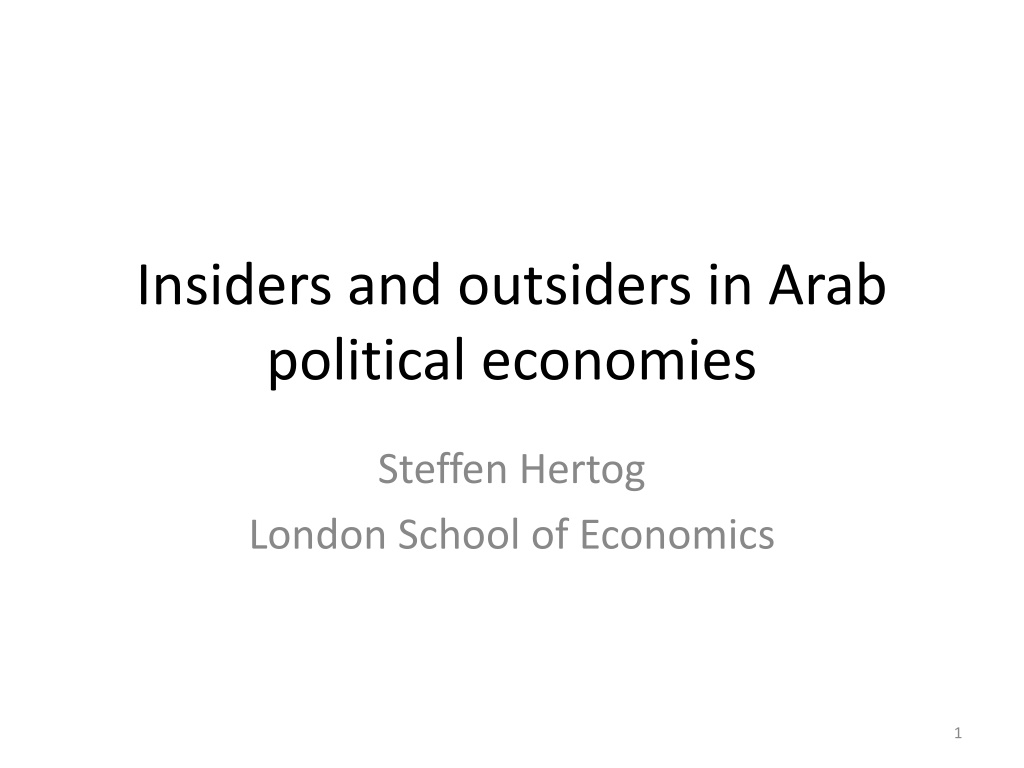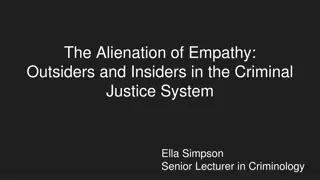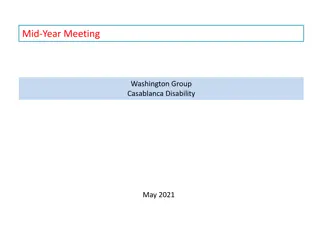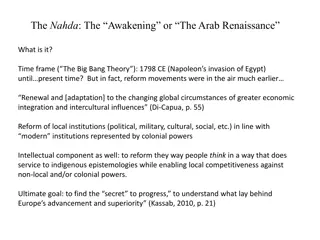Understanding Insiders and Outsiders in Arab Political Economies
Examining core Arab countries outside the Gulf, this analysis delves into the unique features of Arab capitalism, highlighting low state capacity, heavy regulation, and segmented labor markets. State intervention plays a crucial role in creating insiders and outsiders, shaping a landscape of low skills and productivity that hinder private-driven growth. This offers a fresh perspective beyond the typical blame on neoliberal reforms for corruption and underdevelopment.
- Arab Political Economies
- Capitalism in Arab Countries
- Insider-Outsider Divides
- State Intervention
- Low Productivity
Download Presentation

Please find below an Image/Link to download the presentation.
The content on the website is provided AS IS for your information and personal use only. It may not be sold, licensed, or shared on other websites without obtaining consent from the author. Download presentation by click this link. If you encounter any issues during the download, it is possible that the publisher has removed the file from their server.
E N D
Presentation Transcript
Insiders and outsiders in Arab political economies Steffen Hertog London School of Economics 1
The next 25 minutes Key features of capitalism in core Arab countries outside of the Gulf Links between the features: a low-productivity equilibrium Historical roots Policy outlook Based on Segmented Market Economies in the Arab World: the Political Economy of Insider-Outsider Divisions (article in Socio-Economic Review, April 2020) AND draft monograph for Cambridge Elements (available on request) 2
An Arab type of capitalism? Discussion focused on core Arab states Algeria Egypt Jordan Morocco Syria Tunisia Yemen Low to moderate levels of rent (compared to GCC) Not until recently involved in major, long-term conflicts Part of a shared ideological space that has influenced development thinking since the 1950s 3
Main descriptive features of core Arab capitalism Low state capacity and deep state intervention Heavy regulation & insider protection for workers and businesses Atomized and segmented labor markets Low-tech, family-based and segmented business sectors Low skill levels 4
Does it all hang together? NB: Analysis inspired by Varieties of Capitalism literature 5
Summary: state intervention creates insiders and outsiders Theoretical starting point: a stretched, over-committed and interventionist state deep insider-outsider divides in private sectors and labor markets resulting from lopsided state intervention low levels of cooperation and trust between state, business and workers an equilibrium of low skills and low productivity that hampers private-driven growth in the region Different from standard academic analyses that blame all corruption and underdevelopment on neoliberal reforms 7
Isnt this typical of all developing countries? Some fundamental parts of this story apply to underdeveloped economies in general: low government capacity segmentation of business and labor into formal and informal markets. But others are regionally specific: relative importance and historical ambition of the state in the economy and, closely related, the relative size of the insider coalitions created through government employment and subsidies. Unusually rigid insider-outsider divisions are cemented by a particularly pronounced weakness of universal social security and safety mechanism Uneven government intervention and market segmentation lead to even lower levers of trust and cooperation between state, business and labour than elsewhere 8
Pillar 1: Low state capacity and deep state intervention Deep intervention not only on labor markets but private business in general Weak capacity in terms of both providing public services (cf. education) and regulating markets % of firms identifying business licenses & permits as a major constraint (WB ent. surveys) % of firms identifying corruption as a major constraint (WB ent. surveys) 80 45 40 70 35 60 30 50 25 40 20 30 15 20 10 10 5 0 0 9
Fraser Institute regulation index scores (2013) 10 regulation index, Fraser 8 Jordan Tunisia Morocco 6 Algeria Yemen Syria Egypt 4 4 6 8 10 12 log of GDP per capita rest of world core Arab countries 10
Deep state intervention also in distributional terms Protection of insiders in business and labor markets through regulation and administrative practices, but also employment and subsidies that benefit the privileged While inclusive social safety mechanisms remain relatively weak 11
Distribution: high state employment Algeria .4 share of public in total employment Jordan .3 Syria Egypt Tunisia .2 .1 Morocco 0 6 8 10 12 log of GDP per capita rest of world core Arab cases 12
Distribution: pre-tax energy subsidies (% GDP) 20 pre-tax energy subsidies %/GDP 15 Egypt 10 Algeria 5 Yemen Jordan Tunisia Morocco 0 6 7 8 log GDP per capita 9 10 11 core Arab countries rest of world 13
Average agreement to statement that government should make sure that everyone is provided for (1- 10 scale, WVS) High expectations vis- -vis government! 14
Pillar 2: Atomized and segmented labor markets State-created segmentation Large, protected government employment (sometimes unionized UGTT) More so than in most other regions Small, fairly heavily regulated (and sometimes unionized) formal private employment According to the World Economic Forum, all non-GCC Arab countries bar Jordan rank in the bottom fifth of 144 countries on labour market efficiency (Jordan is 97th) Large informal employment, large (esp. youth) unemployment, esp. among graduates Generally low trade union density (3.4% in Egypt in 2008!) and weak collective bargaining Triple rather than double segmentation as in other developing countries 16
High state employment Algeria .4 share of public in total employment Jordan .3 Syria Egypt Tunisia .2 .1 Morocco 0 6 8 10 12 log of GDP per capita rest of world core Arab cases Higher job security and (as far as we know) higher average salaries than in private sector, incentivizing queuing on labor markets 17
Government continues to pay best (based on national LF surveys / ERF) 18
Public employment in comparison Arab shares of public in total employment mostly lie between 20 and 40%, far above those in richer Latin America, where they range from 4 to 15% (OECD 2014, 61) sub-Saharan Africa, where they range from 2 to 9% (Monga and Lin 2015, 138), or East Asia and Pacific, where they mostly lie below 5% 19
Distribution of formal employment, % While in both Latin American and sub-Saharan Africa, formal private employment is larger Weak formal job creation by undynamic Arab firms 20
Extra-low mobility between segments Hiring in formal private sector jobs in MENA unusually strongly affected by personal networks (Gatti, Morgandi, and Grun 2013, 189) limited skills acquisition incentives Very few workers leave the public sector with its security and benefits for private employment (Gatti, Morgandi, and Grun 2013, 52) while in Latin America e.g., patronage employment in the public sector can be is subject to considerable turnover when new governments come in (Schuster 2015). Informality typically lasts longer than in other countries (Gatti et al. 2014, 187; Gatti, et al. 2013, 153) Labor turnover is generally low in the region, with new hires and job losses generally below 10% of the stock of workers (Gatti, Morgandi, and Grun 2013, 150f.) Transition matrices show unusually infrequent switches between employment statuses and sectors over time 22
Share of long-term unemployed among all unemployed 100 share long-term unemployed in total unemployed Egypt 80 Algeria Morocco 60 Tunisia Jordan 40 Yemen 20 0 4 6 8 10 12 log of GDP per capita rest of world core Arab countries 23
Bismarckian social security favours formally employed insiders Gross replacement rate around the World, by level of earnings and region (percentage of individual earnings ) 140 120 100 80 mean minimum 60 maximum 40 20 0 MENA OECD Eastern Europe and Central Asia Latin America and Caribbean 24
Lack of other social safety mechanisms Of 13 countries covered in a 2005 report on MENA pensions, only 3 had an integrated system of public and private pensions (Robalino 2005) Few unemployment insurance systems that could facilitate labor market mobility deepening segmentation 25
Insiders tend to be older (national labour force surveys / ERF) 26
Insiders tend to be older (national labour force surveys / ERF) 27
Political consequences Insiders are better organized (e.g. unions with public sector orientation incl. UGTT in Tunisia) Formal employees in private sector are only a small political constituency Outsiders often do not demand inclusive reforms but rather to become insiders themselves e.g. demands for public jobs in demonstrations Political feedback loops reproduce the system Outsiders are young and frustrated continued political unrest 28
Pillar 3: Segmented and unproductive business sectors Legacy of state intervention also divides private sector into insiders and outsiders Heavy regulation, unresponsive bureaucracy Extensive protection, subsidy regimes Extensive state-business crony networks Segmentation of private sectors into small, unconnected (and often informal) firms on one hand and large, connected firms on the other Missing middle low dynamism and weak job creation low competitiveness and technology use 29
Causes: World Bank Doing Business rankings 200 Syria (2010) Yemen Algeria 150 Doing Business Rank Egypt Jordan 100 Tunisia Morocco 50 0 4 6 8 10 12 log of GDP per capita rest of world core Arab countries 30
Causes: percentage of firms identifying corruption as a major constraint (WBES) 100 Yemen 80 corruption as major constraint Syria Algeria 60 Egypt Morocco 40 Tunisia Jordan 20 0 4 6 8 10 12 log of GDP per capita rest of world core Arab countries 31
Differential barriers to administrative access Arguably related: weak collective organization of business (Hertog et al. 2013) absence of formal intermediary institutions for both labor and business preference for individual, informal solutions 32
Number of new limited liability companies registered per 1000 inhabitants (2000-2009 average) 33
Again, extra-low mobility between segments Variation in waiting times for regulatory services in the Arab world is higher than in most other emerging economies, especially in Egypt, Jordan, Tunisia, Yemen and Morocco (World Bank 2014, 49f.) Firms in MENA on average are older, there are fewer firm entries and exits and generally fewer registered firms than in other regions. Creative destruction is limited (World Bank 2009; Gatti, Morgandi, and Grun 2013). The dispersion of value-added within sectors is particularly high, indicating lack of competition (World Bank 2009, 103) 34
Informality is sticker Mobility to formal sector in MENA particularly low evidence of deeper segmentation (World Bank data) 35
Egypt: firm segmentation by age and size Source: World Bank, 2014, Jobs or Privileges . 36
Political consequences Weak collective business organization, again mostly protecting insiders Policy demands by business associations usually reflect insider interests in protection, not interests of small firms in general reform (Benhassine, 2009, p. 187; Malik and Awadallah, 2013) Many businesses pursue individual, not collective strategies to deal with government Political feedback loops reproduce insider-outsider divisions Insider cartels reduce citizen trust in business 37
Percentage of respondents with no confidence at all in large companies (WVS) 38
Pillar 4: Low skills Overstretched states provide mass, but low-quality education For the most part, worse skills outcomes than in comparator regions Historical orientation of education system towards public employment which remains preferred employment path for most Same time, very limited investment in skills in segmented, weak private sector Either unable or not incentivized to improve their workers skills Job-seekers themselves have limited incentives to improve skills, given scant formal employment opportunities 39
States provide mass, but low-quality education Similar to their approach to public employment a stretched social contract Underperforming, badly selected teachers themselves are part of a low- effort, low-return social contract 40
Firms do not step in to provide skills Limited incentives for insider firms to improve skills Inability of outsider firms to improve skills 41
Share of students in arts and humanities in core Arab countries (2012, UNESCO) A low-skill trap in which sheltered, uncompetitive companies provide few formal jobs and have weak incentives to upgrade technologically labor markets give few incentives to acquire advanced skills Weak skills in turn boost job-seekers demand for government jobs 44
Historical roots? Interventionist, distributional states as a legacy of the Arab nationalist period from the 1950s on? Nationalist-populist republics in the lead Socialist-tinged development programs Deep state intervention weakening business and labor as autonomous groups Great distributional and developmental ambitions in principle, but under-achieving in practice Leading to capacity strains, insider-outsider systems, corrupt resource allocation and declining trust? Monarchies had to follow republican development model in the face of severe ideological competition esp. Jordan (in the Mashreq ideological heartland), Morocco less so Tunisia as an early drop-out from Arab socialism and regional ideological rivalry also less affected 46
Differences between republics and monarchies Republics closer to the Arab ideal type of deep intervention, intervention failure and resulting distrust At the same time, stronger distributional legacies 47
Policy implications for the wider MENA region Decouple welfare from public employment (and subsidies) Provide exit paths for incumbent public employees (golden handshakes?) A slimmed public sector will also provide a more efficient business environment Expand non-contributory welfare, minimum income guarantees etc. to allow risk-taking in private sector and make private employment more attractive Build new political coalitions that can overcome insider-outsider divisions e.g. inclusive unions, business associations Leverage democratic openings to mobilize outsiders! 50























